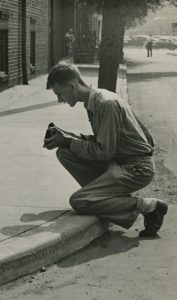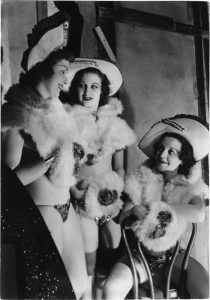Month: December 2017
Born in Philadelphia, both sides of his family descended from late nineteenth century Lithuanian immigrants. Edward Wallowitch pursued his talent for photography early and began taking photos when he was just eleven. At the age of eighteen, he was the youngest photographer to be included in “The Family of Man”, Edward Steichen’s legendary exhibition held in 1955 at The Museum of Modern Art, meaning he was the youngest photographer ever to have prints in the Museum of Modern Art in New York. Two of them were taken with a Brownie box reflex camera while he was still at high school.
Wallowitch was a close friend of Andy Warhol in the 1950s and 60s in New York. By then he had moved from Philadelphia to Manhattan and had become an integral part of the Greenwich Village bohemia, alongside his brother John, and sister Anna Mae. Wallowitch produced a kind of poetic street photography with strong sensibility, showing a tender eye for both composition and texture. He spent a lot of his time photographing children and teenagers.
Many of Wallowitch’s pictures served as source material for Andy Warhol’s drawings. He died at the age of 48, cause of death unknown.

Margaret Bourke-White was a pioneering figure in 20th century documentary photography and is famous for her scenes of modern industry, of the Great Depression, and of political and social movements in the 1920s through 1950s.
As a founding mother of LIFE (she shot the first cover), she became a world-famous symbol of swashbuckling photography. And that she did it in a male world made her success even more spectacular.
During her unique career, Bourke-White was torpedoed in the Mediterranean, strafed by the Luftwaffe, stranded on an Arctic island, bombarded in Moscow, and pulled out of the Chesapeake when her chopper crashed. She was the first Western photographer to document Soviet industry after the revolution, to create a travelog of Czechoslovakia and other Balkan states just before Hitler moved in to ignite World War II, and to be stationed in Moscow just before Germany bombed its former ally.
Aggressive and relentless in pursuit of pictures, Bourke-White had the knack of being at the right place at the right time. For example, she interviewed and photographed Mohandas K. Gandhi a few hours before his assassination in India. And she was the only American photographer in the Soviet Union in 1941 while the battle for Moscow raged. Alfred Eisenstaedt, her friend and colleague, said she was great because there was no assignment, no picture that was unimportant to her. She was also credited for starting the first photo lab at LIFE.
As an artist, Bourke-White continued to use photography as an instrument to examine social issues from a humanitarian perspective.
She witnessed and documented some of the 20th century’s most notable moments, including the liberation of German concentration camps by General Patton in 1945, the release of Mahatma Gandhi from prison in 1946, and the effects of South African labor exploitation in the 1950s. She was a great and tenacious photographer. Her work was her life, and her life was flamboyantly spectacular. Her career was cut short in 1966 due to Parkinson’s disease, she died in 1971.

Floris Neusüss is a pioneer of photographic art, particularly known for cameraless techniques and photograms. Neusüss is drawn to this particular method of photography because, as he describes, “perspective and horizon are absent from photograms, so the space is theoretically unending.” He thinks of these more like paintings than photographs because he composes his works in a step-by-step process, and also modifies his prints with brushes or rags dipped in chemicals in painterly gestures. Neusüss is perhaps most famous for his full-body photograms, first shown in the 1960s, which resulted in monumentally sized prints. In the 1970s, he made his Nudograms, so named for their nude subjects. Neusüss draws inspiration from the work of Man Ray and László Moholy-Nagy.
Born in Lennep, Germany, in 1937, Neusüss has dedicated his whole career to extending the practice, study and teaching of the photogram. Alongside his work as an artist, he is known as an influential writer and teacher on camera-less photography. Neusüss brought renewed ambition to the photogram process, in both scale and visual treatment, with the Körperfotogramms (or whole-body photograms) that he first exhibited in the 1960s. Since that time, he has consistently explored the photogram‘s numerous technical, conceptual and visual possibilities.
His works often deal in opposites: black and white, shadow and light, movement and stillness, presence and absence, and in the translation of three dimensions into two. By removing objects from their physical context, Neusüss encourages the viewer to contemplate the essence of form. He creates a feeling of surreal detachment, a sense of disengagement from time and the physical world. Collectively, his images explore themes of mythology, history, nature and the subconscious.
Selected recent exhibitions
2017
Leibniz’ Lager. Sammlungswelten in Fotogrammen, ZKM Karlsruhe, Karlsruhe, Germany
2012
Traumbilder. Fotografien 1958 bis 1983, June 22 – Oct 14, Münchener Stadtmuseum, Germany
2011
A History of Camera-less Photography, Oct 13, 2010 – March 23, V&A Museum, London, UK
2008
Wunderkammer Museum, Deutsches Museum, Munich, Germany (solo)






 +49 89 29 73 42
+49 89 29 73 42